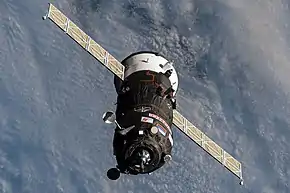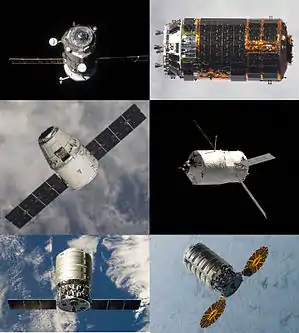Progress MS-12
Progress MS-12 (Russian: Прогресс МC-12), Russian production No.442, identified by NASA as Progress 73P, was a Progress spacecraft used by Roscosmos to resupply the International Space Station (ISS).[3] This is the 164th flight of a Progress spacecraft.
 Progress MS-12 approaches the ISS. | |
| Names | Progress 73P |
|---|---|
| Mission type | ISS resupply |
| Operator | Roscosmos |
| COSPAR ID | 2019-047A |
| SATCAT no. | 44455 |
| Mission duration | 121 days |
| Spacecraft properties | |
| Spacecraft | Progress MS-12 s/n 442 |
| Spacecraft type | Progress-MS |
| Manufacturer | RKK Energia |
| Launch mass | 7392 kg [1] |
| Payload mass | 3434 kg |
| Start of mission | |
| Launch date | 31 July 2019, 12:10:46 UTC [2] |
| Rocket | Soyuz-2.1a s/n N15000-035 |
| Launch site | Baikonur, Site 31/6 |
| Contractor | Progress Rocket Space Centre |
| End of mission | |
| Disposal | Deorbited |
| Decay date | 29 November 2019, 14:19 UTC |
| Orbital parameters | |
| Reference system | Geocentric orbit |
| Regime | Low Earth orbit |
| Inclination | 51.66° |
| Docking with ISS | |
| Docking port | Pirs |
| Docking date | 31 July 2019, 15:29 UTC [2] |
| Undocking date | 29 November 2019 10:25 UTC [3] |
| Time docked | 121 days |
| Cargo | |
| Mass | 3434 kg |
| Pressurised | 1164 kg |
| Fuel | 850 kg |
| Gaseous | 51 kg |
| Water | 420 kg |
Progress ISS Resupply | |
History
The Progress-MS is a uncrewed freighter based on the Progress-M featuring improved avionics. This improved variant first launched on 21 December 2015. It has the following improvements:[4][5][6][7]
- New external compartment that enables it to deploy satellites. Each compartment can hold up to four launch containers. First time installed on Progress MS-03.
- Enhanced redundancy thanks to the addition of a backup system of electrical motors for the docking and sealing mechanism.
- Improved Micrometeoroid (MMOD) protection with additional panels in the cargo compartment.
- Luch Russian relay satellites link capabilities enable telemetry and control even when not in direct view of ground radio stations.
- GNSS autonomous navigation enables real time determination of the status vector and orbital parameters dispensing with the need of ground station orbit determination.
- Real time relative navigation thanks to direct radio data exchange capabilities with the space station.
- New digital radio that enables enhanced TV camera view for the docking operations.
- The Ukrainian Chezara Kvant-V on board radio system and antenna/feeder system has been replaced with a Unified Command Telemetry System (UCTS).
- Replacement of the Kurs A with Kurs NA digital system.
Pre-launch
In 2014, the launch was planned for 1 July 2018, rescheduled for 5 June 2019 and rescheduled to 31 July 2019. The liftoff had been initially set for the two-day rendezvous profile with the station, but the launch time was later shifted to enable a two-orbit (three-hour) flight to the station.[8]
Launch
Progress MS-12 was launched in 31 July 2019, at 12:10:46 UTC from Baikonur Cosmodrome in Kazakhstan, using a Soyuz-2.1a rocket.[3][9]
Docking
Progress MS-12 docked with the Pirs docking module. The docking took place 3 hours 18 minutes 31 seconds into the mission (a new record time).
Cargo
The Progress MS-12 spacecraft delivered 1,164 kg (2,566 lb) of dry cargo (in the cargo compartment).[3]
- 420 kg (930 lb) of water (in the Rodnik-system tanks)
- 51 kg (112 lb) of oxygen (in pressurized bottles)
- 850 kg (1,870 lb) of propellant in the refueling section
- 880 kg (1,940 lb) of propellant in the integrated propulsion system to the International Space Station.
The dry cargo consisted of:[3]
- 394 kg (869 lb) of hardware for onboard systems
- 27 kg (60 lb) of medical supplies
- 1 kg (2.2 lb) of personal protective gear
- 190 kg (420 lb) of hygiene items
- 7 kg (15 lb) of repairs and servicing equipment
- 20 kg (44 lb) of means of crew support
- 282 kg (622 lb) of food
- 13 kg (29 lb) of payloads
- 38 kg (84 lb) of structural components and other hardware
- 192 kg (423 lb) of NASA cargo.
Undocking and decay
The Progress MS-12 craft undocked from ISS on 29 November 2019 at 10:25 UTC, initiated braking maneuver at 13:39 UTC, re-entered Earth's atmosphere at 14:11 UTC (end of mission), with any remaining debris impacting a remote part of Pacific Ocean at 14:19 UTC.[3]
References
- Spiteri, George (October 2019). "ISS Report" (PDF). Spaceflight. British Interplanetary Society. 61 (10): 8–13.
- Joachim Wilhelm Josef Becker (31 July 2019). "ISS: Expedition 60". SpaceFacts. Retrieved 30 November 2019.
- Zak, Anatoly (31 July 2019). "Progress MS-12 arrives at ISS". RussianSpaceWeb. Retrieved 30 November 2019.
- Gunter Krebs (1 December 2015). "Progress-MS 01-19". Gunter's Space Page. Retrieved 30 November 2019.
- "Progress MS-12 2019-047A". NSSDCA. NASA. 31 July 2019. Retrieved 30 November 2019.
 This article incorporates text from this source, which is in the public domain.
This article incorporates text from this source, which is in the public domain. - Zak, Anatoly (31 July 2019). "Progress-MS". RussianSpaceWeb. Retrieved 30 November 2019.
- Zak, Anatoly; Chabot, Alain (16 June 2020). "Soyuz prepares for new tourists". RussianSpaceWeb. Retrieved 22 August 2020. (subscription required)
- NASA Office of Inspector General (28 June 2016). NASA's Response to SpaceX's June 2015 Launch Failure: Impacts on Commercial Resupply of the International Space Station (PDF) (Report). NASA Office of Inspector General. p. 13. Retrieved 18 July 2016.
 This article incorporates text from this source, which is in the public domain.
This article incorporates text from this source, which is in the public domain. - "Status: Progress MS-12". Next Spaceflight. 31 July 2019. Retrieved 30 November 2019.
